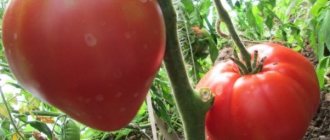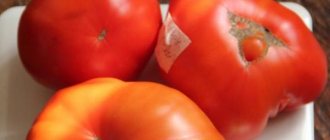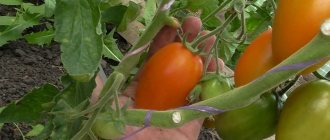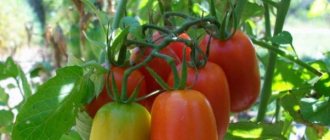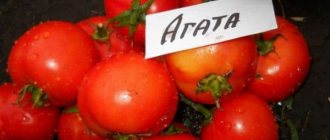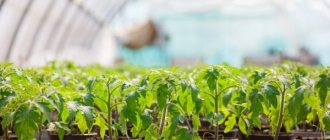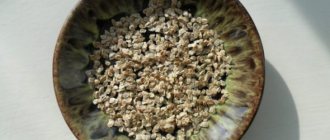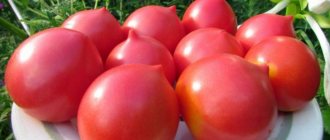» Vegetable growing » Tomatoes » Tomato variety Firewood
0
5373
Article rating
Compact and easy to care for, the Drova tomato is valued for the unusual shape of the fruits and their abundance on the bush. This plant is often grown not only in an open garden bed, but also on a balcony or terrace as a decorative and fruitful crop.
- Advantages and disadvantages
- Growing seedlings
- Basic care
- Transplanting to a garden bed
- Site preparation
- Planting scheme
- Care requirements
- Common mistakes when growing
- Reviews from gardeners
Tomato variety Firewood
General information about the variety
According to the description, the tomato variety Drova is a determinate and early-ripening crop. It is widespread in many regions of our country, but was bred specifically for risky farming zones - Siberia and the Urals. In this area, the seedling method of cultivation is used. In the south, seeds can be sown directly in open ground.
Bush
The plant has compact dimensions - the height of the stems varies from 30 to 40 cm in open ground, in greenhouse conditions the maximum height is about 50 cm. Such bushes do not take up much space in the garden, which is very beneficial for small areas.
The root system of tomatoes is poorly developed, so they successfully grow and bear fruit in large pots or buckets.
The shoots are massive, weakly leafy. The leaf blade is dark green, slightly dissected along the edge. After three or four flower clusters appear, the growth of the bush stops. During this period, the stage of filling and ripening of vegetables begins.
Fruit
According to the description, the fruits are of an unusual pepper-shaped shape - thin and long. Outwardly, they resemble a log with a fork at the tip. The length varies from 10 to 15 cm, the average weight is from 60 to 80 g.
From 9 to 13 ovaries are formed on one fruit cluster; after ripening, they have approximately the same size and shape. The surface is bright red, dense, does not contain greenery in the area of the stalk.
The pulp has a juicy structure, two-chamber, with a small number of seeds. The aroma is rich, the taste is sweet without sourness.
Tomatoes are intended for fresh consumption and for storing for the winter. They do not crack during heat treatment, so they can be successfully preserved entirely.
Lecho, adjika, juice, paste and ketchup are prepared from sweet tomatoes. Ripe and sliced vegetables are great for drying and drying. They are readily used to prepare Caucasian and Italian sauces, as well as various salads.
Harvesting and application
Tomatoes are harvested in July-August, depending on when they were planted. The fruits do not ripen gradually, but simultaneously. Sometimes, to lighten the weight that the bushes experience, some half-ripe tomatoes are picked off and left to ripen at home.
Tomatoes are universal in consumption. Suitable for salads, first and second courses. Tomatoes are used to make tomato paste, juice, and winter preparations.
Advantages and disadvantages
Tomatoes of the Drova variety have some positive characteristics that you should definitely pay attention to.
- Early ripeness - the harvest appears 90-100 days after emergence;
- Unusual shape and good presentation;
- Thanks to their dense surface, tomatoes can easily be transported;
- During the ripening process, the fruits do not crack; when ripe, they are stored for about 3 months in a cool place;
- Another important quality of fruits is rapid ripening;
- The plant is immune to almost all fungal infections;
- Due to its good resistance to sudden temperature changes, this crop is successfully cultivated in Siberia and the Urals;
- The yield indicators are high - 1.5-2 kg can be harvested from one bush.
The fruit has an unusual shape
The description of the variety includes the possibility of growing in any conditions (in a greenhouse, on a balcony, an open bed) and the absence of the need for pinching, which greatly facilitates the care of bushes.
This variety is demanding on soil fertility, which is the only drawback. On poor soil it will be difficult to grow and bear fruit, so at the growth stage it is necessary to fertilize in order to get a decent harvest.
Rules for planting and caring for Drova variety tomatoes
To obtain a high level of productivity, it is necessary to properly plant the planting material, obtain seedlings and subsequently care for them. The work algorithm looks like this:
- The first thing you need to do is select suitable containers and sow planting material – tomato seeds of the Firewood variety.
- After the seedlings have grown to the required size, they are picked and planted in separate containers for further growth.
- As soon as the frosts have passed and the soil has been prepared, you can begin planting seedlings in open ground or in a greenhouse.
- As they grow, Drova tomatoes need to be looked after. To do this, you need to water the bushes, treat them against possible pests, mulch the soil, and apply fertilizers.
- Once the fruits are fully ripe, you can begin harvesting. As a rule, the harvest is harvested 90-110 days after planting in open ground.
Attention! If you approach this issue responsibly, you can get a good harvest.
Planting seedlings
Tomatoes of the Drova variety must be planted as seedlings in the second half of February. For disinfection, use a weak solution based on potassium permanganate. In addition, you need to pay due attention to the soil - pre-heat it in a water bath, which will neutralize the soil from pest eggs and weed seeds present in it.
Judging by the reviews, photos and descriptions of the Drova tomato variety, some gardeners pick seedlings. To do this, 2-3 full leaves should appear on young tomato bushes. Seedlings are transplanted after the temperature outside has become stable and ranges from + 15 °C and above. You must first harden the tomato bushes - you should take the seedlings outside, increasing the time they stay.
Advice! Despite the fact that this variety has a high germination rate, it doesn’t hurt to check the seeds. To do this, planting material is poured into a glass of water. Those grains that float to the surface are empty and should be thrown away.
Transfer
Tomato variety Drova can be planted in a permanent place of growth after the seedlings are 55 days old and picking has been carried out. They can be planted in a greenhouse when the soil has been prepared, regardless of the temperature outside. It can be transferred to open ground after the temperature is stable at + 15 °C and above. If the temperature is lower, then you should wait a while. Between the bushes it is necessary to make a distance of 50 to 60 cm; if necessary, the planting can be more dense.
Important! Despite the fact that the bushes are compact, you still need to take care of the supports, since the bushes can break under the weight of a large number of fruits.
Aftercare
If you plan to grow Firewood tomatoes at home on a windowsill, then you should first fill the container with drainage, which will provide the necessary amount of moisture and air.
When planting in open ground, you should take care of protection from pests. For these purposes, a small amount of crushed eggshells and onion peels is poured into each hole.
If the soil is not fertile, then you can use peat or humus, which is poured to the bottom. It is important to note that the fertilizer layer must be covered with a thin layer of soil, otherwise the root system will get burned.
It is worth watering the tomatoes as needed, making sure the soil is not waterlogged or too dry. After planting, the soil is mulched to reduce the growth of weeds. Organic matter or minerals can be used as fertilizers.
Attention! Tomatoes of the Drova variety love fertile, loose soil.
Growing seedlings
The technology for growing seedlings at home consists of several stages.
- To plant the Drova variety, it is better to use purchased tomato seeds with the current expiration date. Material collected from last year's harvest should be pre-processed. First you need to discard unsuitable seeds - dip them in a saline solution (½ tsp per 0.5 liters of water). After half an hour of soaking, all the seeds that have sunk to the bottom are removed, washed and dipped in a raspberry solution of potassium permanganate for half an hour. This will help destroy all pathogenic microflora. After treatment, the seeds are dipped in Epin solution for half an hour, which will increase the percentage of their germination and good growth. Before sowing, the seeds are placed in damp gauze and kept for a day in a warm and dark place. This way they will hatch faster and sprout.
- Preparing containers. It is better to use disposable containers or peat tablets - then there will be no need for picking. When planting in boxes or plastic containers, the grown seedlings will need to be planted in separate containers. Requirements for planting containers: height of at least 10 cm, presence of drainage holes.
- For seeds, it is necessary to use light, loose and fertile soil, preferably with a neutral acidity level. A balanced composition for growing vegetable crops is sold in any gardening store. You can prepare it yourself - mix equal parts of garden soil, humus and sand. Before use, the soil must be sterilized: treated with a raspberry solution of potassium permanganate, calcined in the oven or poured with boiling water.
- Sowing technique. The optimal timing is the end of March or the beginning of April. In 55-60 days, the seedlings will be ready to be transplanted into an open bed or greenhouse. In boxes, seeds are sown in grooves up to 1 cm deep and at a distance of 3-4 cm from each other. In disposable containers, place 2 seeds on the surface of the soil and sprinkle with a thin layer of sand.
Features of cultivation and storage
The bushes are placed in a permanent place when they are 50-55 days old.
How to grow in the garden and on the balcony?
In the beds on the site, seedlings are transplanted into lighted, windless places. The best predecessors are carrots, phacelia, beets, and peas.
How to grow:
- watering 3 times a week;
- mulching;
- fertilization;
The bushes do not take steps.
To grow at home, the bushes are transferred to pots with a capacity of 4-5 liters. Drainage and soil fertile substrate are laid. Features of care on the balcony:
- additional lighting in winter;
- moderate watering;
- feeding
Basic care
To obtain strong sprouts, it is necessary to create certain conditions:
- cover the crops with transparent film or glass;
- place in a warm place with diffused light;
- the optimal temperature for germination is 25-27°C, humidity - 60%;
- You need to periodically ventilate and irrigate the dried soil.
5-7 days after the sprouts appear, the shelter is removed and the seedlings are placed in a well-lit but cool place. For a week, the seedlings are kept at a temperature of 18-19°C to prevent them from stretching and stimulate root growth. Then the sprouts are returned to their original location.
When two true leaves are formed, the sprouts are planted. Before planting in a larger container, the crops are watered abundantly and then removed along with the earthen clod. The voids are filled with fertile soil - garden soil mixed with humus (1:1).
For better survival, the sprouts need to be fed with an azofoska solution (1 tbsp per 5 liters of water) or a urea solution (1 tbsp per bucket of water). Consumption per plant - 50 ml.
():
During picking, the root system of a seedling consists of almost one root, which during picking breaks off on its own or is pinched specifically to stimulate the growth of lateral roots. There is not and cannot be any “clump of earth” on the roots of the seedlings.
Transplanting to a garden bed
Typically this procedure is carried out in late spring - early or mid-May. By this time, the plants will get stronger, reach a length of 25-30 cm and form 5-6 leaves.
Site preparation
In an open garden for tomatoes, choose a sunny place with the possibility of shading during lunch hours. The soil should be light, loose and neutral acidity. Before planting tomatoes, the area is cleared of weeds and last year’s vegetation, and sprayed with a solution of copper sulfate for disinfection (1 tbsp per bucket of water).
():
No shading is needed, especially in areas of central Russia and to the north. The more sun a plant receives, the sweeter its fruits will be.
A day after treatment, sprinkle with humus - 10 kg, ash - 3 kg and superphosphate with potassium salt - 100 g/m². The soil is dug up, leveled with a rake and watered.
():
Digging and fertilizing are carried out in the fall, so it is strictly forbidden to level the soil with a rake after this, much less water it.
Planting scheme
Tomatoes need to be fed
Drowa tomatoes have a compact bush shape, so they do not require much space on the site - the optimal planting pattern is 40x50 cm.
Each hole is spilled with water, then the plants are planted, pressing the soil around the stem and covering it with garden soil.
Care requirements
In the first days of adaptation, tomatoes need to be covered with any material from the sun, and at night - from the cold.
Aftercare consists of several activities.
- Plants begin to be watered a week after planting. To avoid burns and rotting of bushes, watering is carried out on cloudy days in the evening or in the morning. Water is poured under the root, and after the moisture is absorbed, the soil is mulched.
- Every other day, loosening, weeding and, if necessary, removal of weeds are carried out.
- During the entire growing season, tomatoes need to be fed at least three times. The first fertilizer is applied three weeks after transplanting the bushes to the garden bed. Use nitrophoska or azofoska - 1 tbsp. l. on a bucket of water. At the beginning of flowering, the bushes are watered with a liquid complex composition of superphosphate (15 g), potassium nitrate (10 g) and 10 liters of water. Each bush uses 0.5 liters of fertilizer. This fertilizing is also applied at the stage of fruit filling. To protect against diseases and improve the quality of flowering and fruiting, you can feed the bushes with boron - 0.2 g of the substance per liter of warm water (60°C). Irrigate the garden bed before and after flowering.
- This plant does not require pinching or staking, as it is small in size and compact in shape. But if you want to get a larger harvest of tomatoes, you should pinch the main stem after 2 flower clusters appear. You can also pluck all the foliage at the bottom of the bush so that the tomatoes can devote all their energy and nutrients to the formation and ripening of vegetables.
- To attract bees to the garden, tomatoes are sprayed with honey solution - 1 tsp. per liter of water. This will increase the amount of harvest.
- Vegetables are harvested 1.5-2 months after transplanting the seedlings to the garden bed. You can pick both ripe and unripe (brown) fruits. They ripen well indoors and are stored in a cool place for several months.
To prevent diseases and pests, seedlings are sprayed with a solution of Bordeaux mixture three weeks after transplantation. Repeated treatment is carried out a week before flowering.
Pests and diseases
Firewood is a variety with good immunity, resistant to diseases characteristic of the crop. Gardeners note even later, compared to other tomatoes, the defeat of late blight, when the main crop has already been harvested.
But, apart from genetically modified tomatoes, there are no varieties yet that are 100% resistant to viruses, bacteria or fungi. Preventive treatments are required. If it is impossible to ensure correct crop rotation on a site, the soil also needs to be disinfected. Spraying soil and tomatoes with Fitosporin or Trichoderma significantly reduces the likelihood of infectious diseases.
Firewood with a lack of calcium is susceptible to blossom end rot, especially the largest fruits. Pests affect the variety in the same way as other tomatoes.
Common mistakes when growing
Due to inexperience, many gardeners, especially beginners, make many mistakes when cultivating. As a result, they get weak seedlings or an overgrown green mass with small and unpalatable fruits. This is possible in the following cases:
- Using contaminated or old seed. The seedlings turn out to be thin, sluggish, sprout unevenly and die quickly.
- Tomatoes do not grow well in cramped containers and do not tolerate acidic, heavy soil.
- To prevent the sprouts from stretching out, they need to be planted in time - at the stage of the appearance of two true leaves.
- Failure to comply with planting deadlines or transplantation into cold and waterlogged soil can lead to the death of sprouts or damage to them by various types of rot.
- Eating disorder. Gardeners often get confused about when and what fertilizers are needed. When applying nitrogen fertilizers, the bush will intensively increase its green mass. Phosphorus-potassium substances ensure good flowering and fruiting. Apply each drug at the right time and be sure to stick to the dosages. Overfeeding can cause tomatoes to stop growing, bloom and bear fruit sparingly.
- Watering, loosening and weeding are necessary to keep the soil moist, light and loose. Without these procedures, the bushes will quickly turn yellow and dry out.
Reviews from summer residents
Svetlana from Belgorod. I grew tomatoes in the garden. The bushes are low and compact. I didn’t pay much attention because I was at work late every day, but I harvested even more than I expected. The fruits are very tasty and do not leak in salads. I was also pleased with the unusual appearance. When canning, many long tomatoes are placed in a jar.
Victor from Orenburg. The tomato was grown in a greenhouse, since our climatic conditions are quite harsh for the crop. The bushes grew a little higher than indicated on the package, but at the same time remained compact. A lot of ovaries have formed. By the end of the season, the entire bush was hung with long clusters of red fruits. I also liked the taste of the tomato.
Tomato Drova will not disappoint under any circumstances. Sweet, elongated tomatoes will quickly become one of your favorite varieties.
